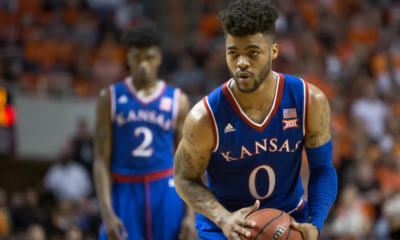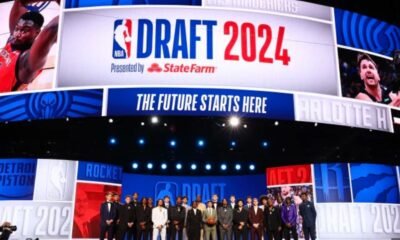NBA
Heat Best Player Voice Dissatisfaction with Management Decisions Over….

When the team’s star player voices dissatisfaction with management decisions, it can create waves of unrest within the organization and among fans. In this in-depth analysis, we explore the implications of the Miami Heat’s best player expressing discontent with management decisions, the root causes of the dissatisfaction, and potential paths forward for the franchise.
The Miami Heat, like many NBA teams, rely heavily on the performance and leadership of their best player to drive success. Whether it’s through on-court production, vocal leadership, or setting an example for teammates, the best player plays a pivotal role in shaping the team’s identity and direction. Therefore, when this key figure expresses dissatisfaction with management decisions, it sends a clear signal that all is not well within the organization.
The specifics of the management decisions that have led to the best player’s dissatisfaction are not disclosed, leaving room for speculation about the underlying issues. However, it’s likely that the decisions in question relate to matters such as roster moves, coaching changes, organizational direction, or perhaps even personal matters unrelated to basketball. Regardless of the specifics, the best player’s expression of discontent is a cause for concern for the Heat organization and its fans.
At the heart of the best player’s dissatisfaction with management decisions lies a misalignment of priorities, values, or visions for the team’s future. Professional basketball is a complex ecosystem where success depends on a delicate balance of talent, chemistry, coaching, and organizational culture. When management decisions diverge from the best player’s expectations or beliefs about what is best for the team, it can create tension and unrest that permeates throughout the organization.
The fallout from the best player’s dissatisfaction with management decisions can have far-reaching implications for the Heat, impacting everything from team chemistry and morale to fan engagement and organizational stability. Professional sports teams are tightly knit communities where trust, unity, and shared purpose are essential for success. When disagreements arise between key stakeholders within the organization, it can erode trust, fracture team chemistry, and undermine the team’s ability to perform at its best.
From a management perspective, the Heat must carefully navigate the delicate task of addressing the best player’s concerns while also safeguarding the organization’s long-term interests. This may involve engaging in open and honest dialogue with the best player to understand their perspective, clarifying the rationale behind management decisions, and finding common ground that allows both parties to move forward in a positive and constructive manner.
For the best player, expressing dissatisfaction with management decisions presents a critical juncture in their relationship with the team and its leadership. As a leader and key contributor, the best player’s influence extends beyond the basketball court, shaping the team’s culture, identity, and direction. How they choose to communicate their concerns, work towards a resolution, and support their teammates through adversity will have a profound impact on the team’s cohesion and performance.
The resolution of the best player’s dissatisfaction with management decisions will require compromise, communication, and a shared commitment to the team’s goals and values. Both parties must be willing to set aside personal differences and egos in the interest of the greater good, recognizing that success in professional basketball is a collective endeavor that requires cooperation and collaboration at every level of the organization.
The broader implications of the best player’s dissatisfaction with management decisions extend beyond the confines of the basketball court to impact the Heat’s brand image, fan base, and standing within the NBA community. The Heat are not just a basketball team; they are a cultural institution with a loyal following and a reputation for excellence both on and off the court. How the organization handles this internal dispute will shape perceptions of the team and its leadership for years to come.
In navigating the unrest caused by the best player’s dissatisfaction with management decisions, the Heat must draw upon their organizational strengths, including their strong leadership, cohesive culture, and track record of success. By fostering open communication, promoting a culture of accountability, and prioritizing the well-being of their players and staff, the Heat can emerge from this challenge stronger and more united than ever before.
For Heat fans, the best player’s dissatisfaction with management decisions may elicit a range of emotions, from concern and frustration to hope and optimism. While disagreements are a natural part of any organization, particularly in the high-pressure world of professional sports, fans ultimately want to see their team succeed and thrive. As the Heat work towards resolving the dispute with their best player and moving forward as a cohesive unit, fans can rally behind their team with confidence, knowing that the organization is committed to upholding its values and pursuing excellence on and off the court.
In conclusion, the best player’s expression of dissatisfaction with management decisions presents a significant challenge for the Miami Heat organization. As both parties work towards a resolution, they must prioritize open communication, mutual respect, and a shared commitment to the team’s goals and values. By navigating this challenge with integrity and determination, the Heat can emerge stronger and more united, poised to continue their pursuit of championship success in the NBA.
-

 NFL2 months ago
NFL2 months agoBREAKING: Steelers Best Quarterback Suspended for 6-Months Due to…
-

 NCAA1 month ago
NCAA1 month agoI am No Longer Comfortable at Illinois Fighting Illini, Quarterback Cal Swanson Cries Out…
-

 NFL2 months ago
NFL2 months agoJust In: Unexpected Name Surfaces in Rumors for Steelers Coaching Position.
-

 NFL2 months ago
NFL2 months agoRaheem Morris threaten to leave Atlanta Falcons if the Owners fails to….
-

 NHL2 weeks ago
NHL2 weeks agoMinnesota Wild Veteran Player Announces Plan to Leave Team, Cites Poor Management…
-

 NFL2 months ago
NFL2 months agoGiants QB Daniel Jones to Undergo 12-Months Suspension After He was Found to be…
-

 NBA2 months ago
NBA2 months agoBREAKING NEWS: LeBron James Has Agreed to Extend His Current Contract at Lakers worth $147.7 millions till…
-

 NHL2 months ago
NHL2 months agoHow should the Chicago Blackhawks handle their unsigned free agents for 2024–2025? Read to Find Out…..












